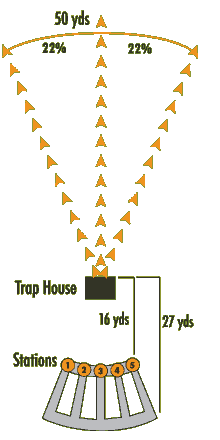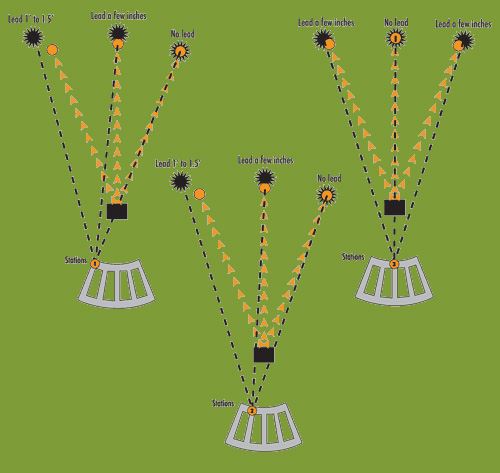TRAP RANGE RULES
NOTE: VIOLATION OF THE RULES WILL NOT BE TOLERATED. SUCH ACTION MAY RESULT IN CRIMINAL PROSECUTION AGAINST ANY OFFENDER & ASSOCIATES.
1. The caution sign must be displayed when the range is in use.
2. NO alcohol or drugs.
3. Guns must be unloaded and actions open except on the firing line / station
4. Guns may NEVER be pointed in the direction of other persons.
5. Guns must be pointer down when carried.
6. When on the firing line:
* keep your gun pointed ahead and unloaded until it is your turn to shoot.
* Guns must be shouldered for firing.
* Pass behind other shooters when moving from #5 to #1.
* In case of a mis-fire, keep the gun closed and pointed straight ahead for 60 seconds.
* If a red flag is raised on the trap house, open actions and unload guns at once.
* All shells must be equivalent to 3 drams / 1 1/8 oz. with # 7.5 shot or less.
* If shooting beyond 27 yards, rope off and mark sidewalks.
*ALL ATA and NSSA Rules apply.
**all firearms must have a barrel minimum length of 25"
CLUB RULES AND REGULATIONS <---- click
What exactly is trapshooting?
Trapshooting, often called "American trapshooting," is a type of clay target or clay pigeon shooting different than sporting clay's or skeet shooting. When trapshooting, movement, action and split-second timing is an essential part of the game. It is sport which requires dedication, patience and the ability to shoot at 4.25 inch disc thrown through the air at a speed of approximately 41 mph, which simulates the flight of game birds fleeing a hunter or bird dog.

The shooter is required to
shoot at the target after he calls “pull.” It does not matter in scoring
if the shooter hits only a small piece of the target or whether he
shatters the target. If the target is hit it is “dead.” If it is missed
then it is “lost“. It is best for the shooter to double check his score
after a round is completed.
The Field
Each trap field has five shooting stations in an arc, each station being 11 degrees away from its neighbor. The shooting stations are paths radiating out from the trap house with distances from the house marked from 16 to 27 yards.
The rules for registered trapshooting according to the ATA (Amateur Trapshooting Association), STRGC is a ATA registered club, specify that targets must be thrown no less than 48 yards no more than 52 yards and should be between 8 and 10 feet high at 10 yards from the trap-house. Shooters typically stand 16 yards from the trap houses but up to 27yards in handicap competition.
THE RULES
The rules of trapshooting
are simple and easy to understand. Hamilton Angling and Hunting
Association follows the rules set forth by the Amateur Trap Association.
For a complete rule book visit the ATA.
THE EQUIPMENT
The first thing you'll need is a gun, specifically a shotgun. Typically a 12-gauge shotgun is used with a full or improved/modified choke and a 30-34 inch barrel with vented rib. The styles of gun vary from single-barrel, double-barrel, pump and auto-loading with prices ranging from a few hundred dollars into the thousands. Go to a gun shop or sporting good store and tell them you want to shoot trap and they will set you up with something that is a good fit for you.
Once you have your gun you will need shells. There are shells specifically designed for trapshooting. They typical are referred to as target loads and will have a shot size of #7-1/2 to 8 and come in boxes of 25. The amount of shot and the charge may differ from one brand to another. Your best bet is try a few and find something you feel works best for you. If you don't know where to start we have a basic target load available at the club for purchase.
The next thing you'll need is safety equipment. Ear protection is a must on the trap field. Plugs are preferred by most shooters because they don't interfere with the fit of the gun. Sheridan Transit has disposable ear plugs available.
Besides your ear protection you will need eye protection. Shooting glasses will protect your eyes from any debris that may come from the shot or while eject the shell. Today's modern lenses also help with making the targets more visible.
A shooting pouch is not an absolute necessity but it comes in handy. The one thing you never want to do on a trap field is cary a shell box and pick shells out of it from the ground, this is distracting not only to you but to other shooters. The styles vary from a simple clip on that holds one box of shells to models that can hold your spent shells, extra shells and even towels and gloves.
These are the basic items you will need to get started but that doesn't that this is all there is. There are gun cases, vests, jackets, gloves and many more items and gadgets available.
 Need more Help Breaking Birds?
Need more Help Breaking Birds?
TIPS
The first step to breaking more birds is to know where to aim your gun or how to lead the targets. Follow the diagrams to determine your lead at each station (station 4 is the opposite of 2, 5 is the opposite of 1).
Once you know your lead the next thing to remember is to always follow through on your shot. You want to use the laws of physics to throw your shot into the path of the target which easily done by following through. If you don't follow through you will find your shots falling behind the targets

What are They Talking About?
Like all sports there are phrases and terms specific trapshooting and other shooting sports. Here is a list of terms used by the ATA(Amateur Trap Association) which you might hear around the field.
All-Around - championship at the Grand, Zone, State and other major shoots based on the combined scores of the 400 championship targets, 200 singles, 100 doubles and 100 handicap.
Average - the percentage of targets the shooter has hit out of the total shot at.
Average Book - yearly book compiled by the ATA listing all singles, handicap and doubles averages of each member who shot during the previous year.
Back-Yardage - positions in handicap shooting from 24 to 27 yards behind the trophies.
Broken Target - a) one which comes out of the trophies in pieces. It is declared “no target” whether the shooter shoots at it or not, and another bird is thrown. It does not count even if the shooter hits it b) a whole target which the shooter hits and is scored as “dead”.
Call - signal given by the shooter for the release of the target. Usually the word “pull,” but any sound may be used.
Classification - a system of diving shooters into groups - based on previous records, ability, etc. - in singles and doubles. Classification is done by a committee of shooters. AA is the highest class; D or E are the lowest.
Dead - the term used for a target broken by the shooter.
Doubles - one of the three events in trapshooting. The shooter stands 16 yards from the trophies and fires twice, once at each target that are fired simultaneously.
Entries - the number of shooters in a specific event.
Field - the trap field ; refers to the entire layout of the trap and shooting positions.
Handicap - singles targets are shot at by shooters standing a minimum of 18 yards and a maximum of 27 yards from the trap.
High-Over-All - championship based on the combined score of all targets in a program. At the Grand it includes 1,000 targets over the final six days.
Junior - any shooter under the age of 18.
Lost - the term for a target missed completely or only “dusted.”
No-Bird - the call given by the referee when the shooter does not have to fire at a target. Ex. A target that is thrown from the trap broken.
Pair - the two targets fired simultaneously in doubles shooting.
Pigeon - clay pigeon, the target.
Puller - the person who releases the target from the trap, either by an electric switch or by hand.
Shoot-off - method of deciding ties in which the shooters fire another event.
Singles - targets are shot at by shooters standing 16 yards from the trap. One shot fired at each target.
Squad - a group shooters (five or less) who shoot together at one trap and who shoot in rotation.
Straight -the breaking of all targets in an event.
Sub-Junior - any shooter under the age of fifteen.
Trap - the device used to propel the target.
Trap-house - a structure 2 1/2 feet below the ground 16 yards in front of the station that houses the trap, trapboy and a supply of targets.
Veteran - at the Grand any shooter age 65 or older.
Zone - a) one of the five districts in which the ATA divides the United States and Canada. b) one of the districts into which various states divide their territories.
Zone Shoots - tournament sponsored by the ATA in each of its five zones and for which the ATA furnishes the major trophies
Didn't find what you were looking for, feel free to email us your question and we will try and help you out.